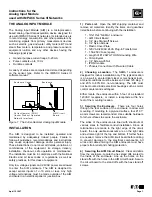
70
8.3 Output signals – External control (PLC)
The LUB-V has invariably defined output signals that are transmitted to the PLC via PIN 4 of the
M12x1 electrical interface depending on the condition of the LUB-V.
Each time a control signal is sent from the PLC to the LUB-V, the LUB-V sends an output signal
after the action caused by the control signal has been executed, which must be waited for, eva-
luated and interpreted by a suitable PLC program.
A high level (+ 24 V DC) is permanently present at PIN 4. During the transmission of the output
signal, the signaling for information transmission changes several times from a high level to a low
level and back again. After sending an output signal, a high level is permanently present at PIN 4.
The following graphic shows an example of an output signal.
00
2244
UU [[VV]]
tt [[m
mss]]
110000 m
mss
PPIIN
N 44
110000 m
mss
Information about the status of the LUB-V and about the past motor run must be evaluated via
an evaluation of the number of edge changes of the output signal. For the evaluation of the edge
changes, the rising edge (change of the output voltage at PIN 4 of the LUB-V from a low level
(0 V) to a high level (+24 V DC)) must always be counted. The counted number of edge changes
corresponds to a one-to-one state of the LUB-V.
The output signal is sent with a frequency of f = 5 Hz. The low level is a voltage of + 0 to 5 V DC,
the high level is a voltage b 17 and + 27 V DC.
Summary of Contents for LUBRICUS LUB-V
Page 1: ...User manual LUB V 24 VDC...
Page 85: ......















































